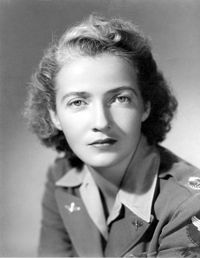Nancy Harkness Love
| Nancy Harkness Love | |
|---|---|

Nancy H. Love, c. 1943
|
|
| Born |
February 14, 1914 Houghton, Michigan |
| Died | October 22, 1976 (aged 62) Martha's Vineyard, Massachusetts |
| Occupation | Aviator Test Pilot Spokesperson Air Force Officer (Rank of Lieutenant Colonel) |
| Spouse(s) | Robert Love |
Nancy Harkness Love (February 14, 1914 – October 22, 1976), born Hannah Lincoln Harkness, was an American pilot and commander during World War II.
Born in Houghton, Michigan on February 14, 1914 as the daughter of a wealthy physician, Harkness developed an intense interest in aviation at an early age. At 16, she took her first flight and earned her pilot's license within a month. Although she went to all the right schools, including Milton Academy in Massachusetts and Vassar in New York, she was restless and adventurous. In 1932, by the end of her freshman year, dubbed, “The Flying Freshman!”, she earned her commercial license and received national attention. At Vassar, she earned extra money taking students for rides in an aircraft she rented from a nearby airport.
In 1936, Harkness married Robert M. Love, an Air Corps Reserve major. They built their own successful Boston-based aviation company, Inter City Aviation, for which Nancy was a pilot. She also flew for the Bureau of Air Commerce.
In 1936 and 1937, Love also entered air races, competing in the National Air Races, in Los Angeles and Detroit. After finishing second in the Detroit race, she no longer continued as an air racer.
In 1937 and 1938, Love worked as a test pilot, alongside famous air racer Frank Hawks, for the Gwinn Air Car Company, performing tests on various aircraft modifications and innovations. In one project, she served as a test pilot on the new tricycle landing gear, which subsequently became standard on most aircraft. In another project, she helped mark water towers with town names as a navigational aid for pilots.
In May 1940, after World War II broke out in Europe, Love wrote to Lt. Col. Robert Olds, then in the Plans Division of US Air Corps Headquarters but, who a year later, would be in charge of establishing the Air Corps Ferrying Command, that she had found 49 excellent women pilots. This group called "the originals" each had more than a 1,000 flying hours. She proposed that the women could help transport aircraft from factories to bases. Olds submitted a plan for integrating civilian female pilots in the Ferrying Command to Gen. Hap Arnold, commanding general of the United States Army Air Forces, who turned it down after Jacqueline Cochran extracted a promise from him not to act on any proposal regarding women pilots that did not make them commissioned officers commanded by women.
...
Wikipedia
